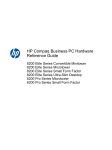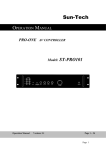Download HP ProOne 600 G1
Transcript
Hardware Reference Guide HP ProOne 600 G1 All-in-One © Copyright 2013 Hewlett-Packard Development Company, L.P. The information contained herein is subject to change without notice. Windows is either a trademark or registered trademark of Microsoft Corporation in the United States and/or other countries. Intel and Core are trademarks of Intel Corporation in the U.S. and other countries. Bluetooth is a trademark owned by its proprietor and used by Hewlett-Packard Company under license. The only warranties for HP products and services are set forth in the express warranty statements accompanying such products and services. Nothing herein should be construed as constituting an additional warranty. HP shall not be liable for technical or editorial errors or omissions contained herein. This document contains proprietary information that is protected by copyright. No part of this document may be photocopied, reproduced, or translated to another language without the prior written consent of Hewlett-Packard Company. First Edition (January 2013) Document part number: 719013–001 About This Book This guide provides basic information for upgrading this computer model. WARNING! Text set off in this manner indicates that failure to follow directions could result in bodily harm or loss of life. CAUTION: Text set off in this manner indicates that failure to follow directions could result in damage to equipment or loss of information. NOTE: Text set off in this manner provides important supplemental information. iii iv About This Book Table of contents 1 Product features ............................................................................................................... 1 Overview ................................................................................................................................ 1 Front components ..................................................................................................................... 3 Side components ..................................................................................................................... 4 Rear components ..................................................................................................................... 5 Keyboard features .................................................................................................................... 6 Positioning the computer ........................................................................................................... 7 Adjusting the height-adjustable/recline stand (optional) ................................................. 7 Adjusting the tilt/swivel stand (optional) ....................................................................... 8 2 Hardware repair and upgrade ....................................................................................... 10 Warnings and cautions ........................................................................................................... 10 Additional information ............................................................................................................ 11 Connecting and disconnecting power ....................................................................................... 11 Connecting power ................................................................................................... 11 Disconnecting power ............................................................................................... 12 Installing and removing the rear port cover ............................................................................... 13 Installing the rear port cover ..................................................................................... 13 Removing the rear port cover .................................................................................... 13 Installing a security lock .......................................................................................................... 14 Installing an access panel security screw ................................................................................... 14 Synchronizing the optional wireless keyboard and mouse ........................................................... 15 Removing batteries from the optional wireless keyboard or mouse ................................................ 16 Attaching the computer to a mounting fixture ............................................................................. 17 Installing and removing a stand ............................................................................................... 18 Installing and removing a height-adjustable/recline stand (optional) .............................. 18 Installing a height-adjustable/recline stand .................................................. 18 Removing a height-adjustable/recline stand ................................................. 19 Installing and removing a tilt/swivel stand (optional) ................................................... 21 Installing a tilt/swivel stand ....................................................................... 21 Removing a tilt/swivel stand ...................................................................... 22 v Connecting a second display ................................................................................................... 24 Locating internal components ................................................................................................... 27 Removing and installing memory .............................................................................................. 28 SODIMMs .............................................................................................................. 28 DDR3-SDRAM SODIMMs ......................................................................................... 28 Populating SODIMM sockets .................................................................................... 29 Installing SODIMMs ................................................................................................ 29 Replacing the battery .............................................................................................................. 32 Replacing drives .................................................................................................................... 35 Replacing a hard disc drive ...................................................................................... 35 Removing a hard disc drive ....................................................................... 35 Removing a 3.5-inch hard disc drive ........................................... 35 Removing a 2.5-inch hard disc drive ........................................... 37 Installing a hard disc drive ........................................................................ 40 Installing a 3.5-inch hard disc drive ............................................. 40 Installing 2.5-inch hard disc drives .............................................. 42 Replacing the optical disc drive ................................................................................ 45 Appendix A Electrostatic discharge .................................................................................... 49 Preventing electrostatic damage ............................................................................................... 49 Grounding methods ................................................................................................................ 49 Appendix B Computer operating guidelines, routine care, and shipping preparation .......... 50 Computer operating guidelines and routine care ........................................................................ 50 Optical disc drive precautions ................................................................................................. 51 Shipping preparation ............................................................................................................. 51 Index ................................................................................................................................. 52 vi 1 Product features Overview Figure 1-1 HP ProOne 600 G1 All-in-One The HP ProOne 600 G1 All-in-One offers the following features: ● Integrated All-in-One form factor ● Full HD IPS, LCD display (1920 x 1080) with LED backlighting ◦ 54.6-cm (21.5-inch) diagonal ● Swivel pad under base of stand ● Adjustable tilt ● Optional height-adjustable and reclining stand ● Removable panel on the back of the computer allows users or technicians to easily and efficiently service the PC ● VESA mounting holes (100 mm x 100 mm) ● 4th generation Intel® Core™ processors ● Up to 2 TB Hard Drive, 160 GB Solid State Drive, 256 GB Self-encrypting Solid State Drive, 500 GB Self-encrypting Drive, or 1 TB Solid State Hard Drive Overview 1 2 ● Optional Tray-load HP SuperMulti DVD+/-RW SATA Optical Disc Drive, DVD-ROM Disc Drive, or Slim BDXL Blu-ray Writer ● Intel Q85 Express chipset ● Two SODIMM slots with up to 16 GB of DDR3 SDRAM memory and dual channel memory support ● Intel integrated graphics ● DisplayPort video out (with audio) for second display support ● Optional MXM graphics card ● DP audio, DP to VGA/DVI/HDMI dongle support ● Integrated Gigabit Ethernet (Intel i217LM GbE LOM) ● Wireless connectivity (optional): ◦ Intel Advanced-N 6205 WLAN, 802.11 a/b/g/n ◦ WLAN and Bluetooth Combo Card, 802.11 a/b/g/n Bluetooth® 4.0 ● Optional integrated full HD webcam and dual microphone array ● Premium stereo speakers ● Optional 6-in-1 media card reader ● 6 USB ports: 4 USB 3.0, 2 USB 2.0 ● Choice of wired or wireless keyboard and mouse ◦ Wired USB keyboard and mouse ◦ Wired PS/2 keyboard and mouse ◦ Wireless keyboard and mouse ● Windows® 7 Professional 32-bit or 64-bit or Windows® 8 Professional 64-bit operating system ● 90-percent energy-efficient power supply ● ENERGY STAR® qualified, EPEAT® Gold+ registered Chapter 1 Product features Front components Figure 1-2 Front components Table 1-1 Front components Component Component 1 Webcam (optional) with privacy shutter 7 Mute speaker 2 Dual microphone array (optional) 8 Reduce volume 3 Webcam activity LED (with optional webcam) 9 Increase volume 4 16:9 widescreen LED-backlit LCD display 10 Mute microphone 5 Power LED 11 Decrease brightness 6 High-performance stereo speakers 12 Increase brightness Touch the icon area (7–12 above) to cause the icons to illuminate, then touch an icon to activate it. To change the volume or brightness, touch and hold the appropriate icon or touch it and repeat until the volume or brightness has reached the desired level. To mute the speaker or microphone, just touch the appropriate icon. The icon remains illuminated until you touch it again to reactivate the speaker or microphone. NOTE: If you mute or reactivate the speaker in a software application, the icon illuminates or darkens accordingly. You cannot mute or reactivate the microphone from a software application. Front components 3 Side components Figure 1-3 Side components Table 1-2 Side components 4 Component Component 1 Hard disc drive activity LED 6 Headset/line out jack 2 HP 6-in-1 media card reader (optional) 7 Tray-load optical disc drive 3 USB 3.0 port, fast-charging 8 Optical disc drive eject button 4 USB 3.0 port 9 Optical disc drive activity LED 5 Microphone/line in jack 10 Power button Chapter 1 Product features Rear components Figure 1-4 Rear components Table 1-3 Rear components Component Component 1 Access panel 7 RJ-45 Gigabit Ethernet port 2 Access panel latches 8 (2) USB 3.0 ports 3 Security lock slot 9 DisplayPort connector 4 Power connector 10 Stereo audio line out 5 (2) PS/2 mouse and keyboard connectors 11 Access panel security screw 6 (2) USB 2.0 ports 12 Serial port (optional) Rear components 5 Keyboard features Figure 1-5 Keyboard features Table 1-4 Keyboard features 6 Component Component 1 Sleep 6 Mute Volume 2 Fast Reverse 7 Decrease Volume 3 Play/Pause 8 Increase Volume 4 Stop 9 Function 5 Fast Forward Chapter 1 Product features Positioning the computer This computer may be shipped with no stand, with a height-adjustable stand, or a tilt/swivel stand. The computer may be placed in the landscape position with the HP logo on the bottom bezel or it may be placed in the portrait position with the HP logo on the right side, as you face the computer. Figure 1-6 Supported and unsupported positions CAUTION: Positioning the computer with the HP logo on the top or on the left is not supported. Adjusting the height-adjustable/recline stand (optional) This stand allows you to: ● adjust the computer height 110 mm (4.3 inches) ● rotate the computer position from landscape to portrait ● recline the computer backward up to +60 degrees ● tilt the computer to 30 degrees from the desktop ● swivel the computer up to 360 degrees right or left To rotate the computer: 1. Grasp the computer by the sides and lift it straight up (1) to its highest position. Figure 1-7 Rotating the computer with the height-adjustable/recline stand 2. Press the top of the computer backwards (2). CAUTION: 3. The computer must be raised and tilted to provide clearance for rotating it. Grasp the top right and bottom left of the computer and carefully turn it counterclockwise (3) until it is in the portrait position (4). Positioning the computer 7 WARNING! If the height-adjustable/recline stand is installed, before laying the computer down for service, first grasp the sides of the display and raise the display to the highest position. Do not lay the computer down with the sliding stand in the low position. The stand may suddenly release, which could cause injury or damage to equipment. Figure 1-8 Laying the computer down with the height-adjustable/recline stand Adjusting the tilt/swivel stand (optional) This stand allows you to tilt the computer forward up to -5 degrees or backward up to +30 degrees to set it to a comfortable eye level. Figure 1-9 Adjusting tilt The tilt/swivel stand has a swivel pad on the underside that allows you to swivel the computer up to 360 degrees left or right for the best viewing angle. 8 Chapter 1 Product features Figure 1-10 Adjusting swivel Positioning the computer 9 2 Hardware repair and upgrade Warnings and cautions Before performing upgrades be sure to carefully read all of the applicable instructions, cautions, and warnings in this guide. WARNING! To reduce the risk of personal injury from electrical shock, hot surfaces, or fire: Disconnect the power cord from the wall outlet and allow the internal system components to cool before touching. Do not plug telecommunications or telephone connectors into the network interface controller (NIC) receptacles. Do not disable the power cord grounding plug. The grounding plug is an important safety feature. Plug the power cord in a grounded (earthed) outlet that is easily accessible at all times. For your safety, do not place anything on power cords or cables. Arrange them so that no one may accidentally step on or trip over them. Do not pull on a cord or cable. When unplugging from the electrical outlet, grasp the cord by the plug. To reduce the risk of serious injury, read the Safety & Comfort Guide. It describes proper workstation, setup, posture, and health and work habits for computer users, and provides important electrical and mechanical safety information. This guide is located on the Web at http://www.hp.com/ergo. WARNING! Computers that are inappropriately situated on dressers, bookcases, shelves, desks, speakers, chests, or carts may fall over and cause personal injury. Care should be taken to route all cords and cables connected to the computer so that they can not be pulled, grabbed, or tripped over. WARNING! Energized and moving parts inside. Disconnect power to the equipment before removing any access panels. Replace and secure all access panels before reenergizing the equipment. 10 Chapter 2 Hardware repair and upgrade CAUTION: Static electricity can damage the electrical components of the computer or optional equipment. Before beginning these procedures, be sure that you are discharged of static electricity by briefly touching a grounded metal object. See Electrostatic discharge on page 49 for more information. When the computer is plugged into an AC power source, voltage is always applied to the system board. You must disconnect the power cord from the power source before opening the computer to prevent damage to internal components. Additional information For more information on removing and replacing hardware components, the Computer Setup utility, and troubleshooting, refer to the Maintenance and Service Guide (available in English only) for your computer model at http://www.hp.com. Connecting and disconnecting power Connecting power 1. If the rear port cover is installed, remove the cover. 2. Route the power and all peripheral cables through the cable management feature. ● If you have the height-adjustable/recline stand, route peripheral cables up through the tube on the side of the stand. ● If you have the tilt/swivel stand, route peripheral cables through the opening in the base of the stand. 3. Connect the peripheral cables to the appropriate ports. 4. Plug the power cord into the power connection on the rear of the computer (1). Figure 2-1 Connecting power 5. Plug the three-pronged power plug into a power outlet (2). Additional information 11 6. If the tilt/swivel stand is installed on the computer, attach the cable management cover: a. Position the cable management cover under the cables and align the cover hooks with the slots in the stand. b. insert the cover hooks into the stand and slide the cover down to secure it. Figure 2-2 Installing the cable management cover 7. Replace the rear port cover. 8. Press the power button on the front of the computer to turn it on. Disconnecting power 12 1. Remove all removable media, such as compact discs or USB flash drives, from the computer. 2. Turn off the computer properly through the operating system, then turn off any external devices. 3. Remove the cable lock, if one is installed on the rear of the computer. 4. If the rear port cover is installed, remove the cover. 5. Disconnect the power cord connector from the port. Chapter 2 Hardware repair and upgrade Installing and removing the rear port cover Installing the rear port cover 1. Be sure that all cables are connected. 2. Place the cover against the computer, lining up the cable lock slot in the cover about 12 mm (0.5 inch) below the cable lock slot in the computer. Slide the cover up and into position. Figure 2-3 Installing the rear port cover Removing the rear port cover 1. If a cable lock is installed on the rear of the unit, remove the lock. 2. Grasp the rear port cover, then pull it down and off the computer. Figure 2-4 Removing the rear port cover Installing and removing the rear port cover 13 Installing a security lock The optional security lock enables you to secure your computer. A cable lock is a key lock device that has a wire cable attached. You attach one end of the cable to your desk (or other stationary object) and the other end of the cable to the cable lock slot on the computer. Secure the cable lock with the key. Figure 2-5 Installing a cable lock Installing an access panel security screw You may prevent access to internal components by securing the access panel. Screw a T15 tamperresistant Torx screw through the left latch of the access panel to prevent removal of the panel. Figure 2-6 Securing the access panel 14 Chapter 2 Hardware repair and upgrade Synchronizing the optional wireless keyboard and mouse The optional wireless keyboard and mouse are easy to set up. Just remove the battery tabs on both the keyboard and the mouse to activate the preinstalled batteries. Also, make sure the Power switch on the bottom of the mouse is in the On position (the keyboard does not have a Power switch). Then, turn on the computer and synchronize them as described below. NOTE: For better mouse battery life and performance, avoid using your mouse on a dark or highgloss surface, and turn mouse power off when not in use. To synchronize the wireless keyboard and mouse: 1. Make sure the keyboard and mouse are next to the computer, within 30 cm (1 foot) and away from interference from other devices. 2. Turn on the computer. 3. Make sure the Power switch on the bottom of the mouse is in the On position. 4. Insert the wireless receiver into a USB port on the computer. Figure 2-7 Installing the wireless receiver 5. Press and hold the Connect button on the wireless receiver for five seconds until the blue activity LED begins blinking. NOTE: When the blue activity LED begins blinking, you have 30 seconds to synchronize the mouse with the wireless receiver. 6. Press and release the Connect button on the bottom of the mouse. The blue activity LED from the wireless receiver turns off when synchronization is complete. NOTE: If the Connect button on the bottom of the mouse is pressed again, the synchronization of the wireless receiver and the mouse will be broken. Turn the mouse off, then on again to restore the synchronization. NOTE: If the procedure does not work, remove and then reinsert the wireless keyboard and mouse receiver from the back of the computer and then synchronize the keyboard and mouse again. If synchronization still does not work, remove and replace the batteries. Synchronizing the optional wireless keyboard and mouse 15 Removing batteries from the optional wireless keyboard or mouse NOTE: The wireless keyboard and mouse are optional components. To remove batteries from the wireless keyboard, remove the battery door on the underside of the keyboard (1) and lift the batteries out of the battery compartment (2). Figure 2-8 Removing batteries from the wireless keyboard To remove batteries from the wireless mouse, remove the battery door on the underside of the mouse (1) and lift the batteries out of the battery compartment (2). Figure 2-9 Removing batteries from the wireless mouse 16 Chapter 2 Hardware repair and upgrade Attaching the computer to a mounting fixture You can remove the computer from the stand and install it on a wall, monitor arm, or other mounting fixture. There is a VESA mount under the computer stand that is used for mounting the computer. Table 2-1 Computer dimensions (without stand) Computer dimensions (without stand) Height 367.4 mm 14.5 in Width 521.9 mm 20.5 in Depth 63.8 mm 2.5 in Minimum configuration 6.63 kg 14.6 lb With Options 7.88 kg 17.4 lb 100 mm x 100 mm 3.94 in x 3.94 in Computer weight (without stand) VESA standard hole patterns height x width Figure 2-10 VESA mounting holes Attaching the computer to a mounting fixture 17 Installing and removing a stand Two stands are available for the computer: ● Height-adjustable/recline stand ● Tilt/swivel stand Installing and removing a height-adjustable/recline stand (optional) Installing a height-adjustable/recline stand To install the stand: 1. Place the computer face down on a soft flat surface. HP recommends that you set down a blanket, towel, or other soft cloth to protect the bezel and screen surface from scratches or other damage. 2. Engage the hooks in the top of the stand in the two large holes in the top of the lower panel, and lower the stand onto the computer. Figure 2-11 Installing the stand 18 Chapter 2 Hardware repair and upgrade 3. Tighten the four captive screws to secure the stand to the chassis. Figure 2-12 Securing the stand Removing a height-adjustable/recline stand To remove the stand: 1. Remove all removable media, such as compact discs or USB flash drives, from the computer. 2. Turn off the computer properly through the operating system, then turn off any external devices. 3. Disconnect the power cord from the power outlet and disconnect any external devices. CAUTION: You must disconnect the power cord and wait approximately 30 seconds for the power to drain before adding or removing memory modules. Regardless of the power-on state, voltage is always supplied to the memory modules as long as the computer is plugged into an active AC outlet. Adding or removing memory modules while voltage is present may cause irreparable damage to the memory modules or system board. 4. Remove/disengage any security devices that prohibit opening the computer. Installing and removing a stand 19 5. Place the computer face down on a soft flat surface. HP recommends that you set down a blanket, towel, or other soft cloth to protect the bezel and screen surface from scratches or other damage. WARNING! Before laying the computer down for service, first grasp the sides of the display and raise the display to the highest position. Do not lay the computer down with the sliding stand in the low position. The stand may suddenly release, which could cause injury or damage to equipment. Figure 2-13 Preparing to remove the height-adjustable/recline stand 6. Push the base of the stand down (1), and loosen the captive screws securing the stand to the unit (2). Figure 2-14 Releasing the stand 20 Chapter 2 Hardware repair and upgrade 7. Lift the stand up and off the computer. Figure 2-15 Removing the stand Installing and removing a tilt/swivel stand (optional) Installing a tilt/swivel stand To install the stand: 1. Place the computer face down on a soft flat surface. HP recommends that you set down a blanket, towel, or other soft cloth to protect the bezel and screen surface from scratches or other damage. 2. Push the release button on the bottom of the stand and pull the back of the stand off. 3. Engage the hooks in the top of the stand in the two large holes in the top of the lower panel, and lower the stand onto the computer. Figure 2-16 Installing the stand Installing and removing a stand 21 4. Tighten the captive screws to secure the stand to the chassis. Figure 2-17 Securing the stand 5. Align the top of the back of the stand with the stand, and press it into place, working along the sides until it is in place. Figure 2-18 Installing the back of the stand Removing a tilt/swivel stand To remove the stand: 1. Remove all removable media, such as compact discs or USB flash drives, from the computer. 2. Turn off the computer properly through the operating system, then turn off any external devices. 3. Disconnect the power cord from the power outlet and disconnect any external devices. CAUTION: You must disconnect the power cord and wait approximately 30 seconds for the power to drain before adding or removing memory modules. Regardless of the power-on state, voltage is always supplied to the memory modules as long as the computer is plugged into an active AC outlet. Adding or removing memory modules while voltage is present may cause irreparable damage to the memory modules or system board. 22 Chapter 2 Hardware repair and upgrade 4. Remove/disengage any security devices that prohibit opening the computer. 5. Place the computer face down on a soft flat surface. HP recommends that you set down a blanket, towel, or other soft cloth to protect the bezel and screen surface from scratches or other damage. 6. Push the release button (1) on the bottom of the stand and pull the back of the stand off (2) the computer. Figure 2-19 Removing the back of the stand 7. Push the base of the stand down (1), and loosen the captive screws securing the stand to the unit (2). Figure 2-20 Releasing the stand Installing and removing a stand 23 8. Lift the stand up and off the computer. Figure 2-21 Removing the stand Connecting a second display The DisplayPort connector on the rear of the computer allows you to connect a second display to the computer. If you are adding a second display that has a DisplayPort connector, then no DisplayPort video adapter is required. If you are adding a second display that does not have a DisplayPort connector, you can purchase a DisplayPort video adaptor from HP for your configuration. DisplayPort adapters and video cables are purchased separately. HP offers the following adapters: ● DisplayPort to VGA adapter ● DisplayPort to DVI adapter ● DisplayPort to HDMI adapter To connect a second display: 24 1. Turn off power to the computer and the second display that you are connecting to the computer. 2. Remove the rear port cover on the computer. Chapter 2 Hardware repair and upgrade 3. If your second display has a DisplayPort connector, connect a DisplayPort cable directly between the DisplayPort connector on the rear of the computer and the DisplayPort connector on the second display. Figure 2-22 Connecting a DisplayPort cable Figure 2-23 Connecting a second display Connecting a second display 25 4. If your second display does not have a DisplayPort connector, connect a DisplayPort video adapter to the DisplayPort connector of the computer. Then connect a cable (VGA, DVI. or HDMI, depending on your application) between the adapter and a second display. NOTE: When a DisplayPort adaptor is used, the rear port cover cannot be installed unless a DisplayPort extender cable is used in conjunction with the adaptor. Figure 2-24 Connecting a second display Using a DisplayPort adapter 5. Replace the rear port cover on the computer. 6. Turn on power to the computer and the second display. NOTE: Use the graphics card software or the Windows Display Settings to configure the second display as a mirrored image of the primary display or an extension of the primary display. 26 Chapter 2 Hardware repair and upgrade Locating internal components The following sections contain procedures for removing and replacing these internal components: ● Memory ● Battery ● Hard disc drive, solid state drive, or self-encrypting drive ● Optical disc drive Figure 2-25 Locating internal components Component Component 1 Optical disc drive 3 Memory 2 Hard disc drive 4 Battery Locating internal components 27 Removing and installing memory The computer comes with double data rate 3 synchronous dynamic random access memory (DDR3SDRAM) small outline dual inline memory modules (SODIMMs). SODIMMs The memory sockets on the system board can be populated with up to two industry-standard SODIMMs. These memory sockets are populated with at least one preinstalled SODIMM. To achieve the maximum memory support, you can populate the system board with up to 16 GB of memory. DDR3-SDRAM SODIMMs For proper system operation, the SODIMMs must be: ● industry-standard 204-pin ● unbuffered non-ECC PC3-10600 DDR3-1600 MHz-compliant ● 1.5 volt DDR3-SDRAM SODIMMs The DDR3-SDRAM SODIMMs must also: ● support CAS latency 11 DDR3 1600 MHz (11-11-11 timing) ● contain the mandatory Joint Electronic Device Engineering Council (JEDEC) specification In addition, the computer supports: ● 1-Gbit, 2-Gbit, and 4-Gbit non-ECC memory technologies ● single-sided and double-sided SODIMMS ● SODIMMs constructed with x8 and x16 SDRAMs; SODIMMs constructed with x4 SDRAMs are not supported NOTE: The system will not operate properly if you install unsupported SODIMM memory. HP offers upgrade memory for this computer and advises that the consumer purchase it to avoid compatibility issues with unsupported third-party memory. 28 Chapter 2 Hardware repair and upgrade Populating SODIMM sockets The system will automatically operate in single channel mode, dual channel mode, or flex mode, depending on how the SODIMMs are installed. Refer to the following table to identify the SODIMM channel locations. Table 2-2 Identifying SODIMM locations Location System board label Channel Lower Socket SODIMM1 Channel A Upper Socket SODIMM3 Channel B ● The system will operate in single channel mode if the SODIMM sockets are populated in one channel only. ● The system will operate in flex mode if the memory capacity of the SODIMM in Channel A is not equal to the memory capacity of the SODIMM in Channel B. In flex mode, the channel populated with the least amount of memory describes the total amount of memory assigned to dual channel and the remainder is assigned to single channel. If one channel will have more memory than the other, the larger amount should be assigned to channel A. ● The system will operate in a higher-performing dual channel mode if the memory capacity of the SODIMM in Channel A is equal to the memory capacity of the SODIMM in Channel B. ● In any mode, the maximum operational speed is determined by the slowest SODIMM in the system. Installing SODIMMs There are two memory sockets on the system board. To remove or install memory modules: 1. Remove all removable media, such as compact discs or USB flash drives, from the computer. 2. Turn off the computer properly through the operating system, then turn off any external devices. 3. Disconnect the power cord from the power outlet and disconnect any external devices. CAUTION: You must disconnect the power cord and wait approximately 30 seconds for the power to drain before adding or removing memory modules. Regardless of the power-on state, voltage is always supplied to the memory modules as long as the computer is plugged into an active AC outlet. Adding or removing memory modules while voltage is present may cause irreparable damage to the memory modules or system board. 4. Remove/disengage any security devices that prohibit opening the computer. 5. Place the computer face down on a soft flat surface. HP recommends that you set down a blanket, towel, or other soft cloth to protect the bezel and screen surface from scratches or other damage. Removing and installing memory 29 6. Slide the access panel latches toward the edges of the unit, then slide the access panel toward the top of the computer until it slides off the unit. Figure 2-26 Removing the access panel 7. To remove a memory module, press outward on the two latches on each side of the SODIMM (1), then pull the SODIMM out of the socket (2). Figure 2-27 Removing a memory module 30 Chapter 2 Hardware repair and upgrade 8. To install a memory module, slide the SODIMM into the socket at approximately a 30° angle (1), then press the SODIMM down (2) so that the latches lock it in place. Figure 2-28 Installing a memory module NOTE: A memory module can be installed in only one way. Match the notch on the module with the tab on the memory socket. 9. To replace the access panel, set the panel on the back of the computer, slightly above the stand, and slide it down into place. Figure 2-29 Replacing the access panel 10. Reconnect the power cord and external devices. 11. Lock any security devices that were disengaged when the access panel was removed. 12. Place the computer in the upright position. 13. Turn on the computer. The computer automatically recognizes the additional memory when you turn on the computer. Removing and installing memory 31 Replacing the battery The battery is located on the system board on the lower right side of the fan. The battery that comes with the computer provides power to the real-time clock. When replacing the battery, use a battery equivalent to the battery originally installed in the computer. The computer comes with a 3-volt lithium coin cell battery. WARNING! The computer contains an internal lithium manganese dioxide battery. There is a risk of fire and burns if the battery is not handled properly. To reduce the risk of personal injury: Do not attempt to recharge the battery. Do not expose to temperatures higher than 60 °C (140 ºF). Do not disassemble, crush, puncture, short external contacts, or dispose of in fire or water. Replace the battery only with the HP spare designated for this product. CAUTION: Before replacing the battery, it is important to back up the computer CMOS settings. When the battery is removed or replaced, the CMOS settings will be cleared. Static electricity can damage the electronic components of the computer or optional equipment. Before beginning these procedures, be sure that you are discharged of static electricity by briefly touching a grounded metal object. NOTE: The lifetime of the lithium battery can be extended by plugging the computer into a live AC wall socket. The lithium battery is only used when the computer is NOT connected to AC power. HP encourages customers to recycle used electronic hardware, HP original print cartridges, and rechargeable batteries. For more information about recycling programs, go to http://www.hp.com/ recycle. 1. Remove all removable media, such as compact discs or USB flash drives, from the computer. 2. Turn off the computer properly through the operating system, then turn off any external devices. 3. Disconnect the power cord from the power outlet and disconnect any external devices. CAUTION: You must disconnect the power cord and wait approximately 30 seconds for the power to drain before adding or removing memory modules. Regardless of the power-on state, voltage is always supplied to the memory modules as long as the computer is plugged into an active AC outlet. Adding or removing memory modules while voltage is present may cause irreparable damage to the memory modules or system board. 32 4. Remove/disengage any security devices that prohibit opening the computer. 5. Place the computer face down on a soft flat surface. HP recommends that you set down a blanket, towel, or other soft cloth to protect the bezel and screen surface from scratches or other damage. Chapter 2 Hardware repair and upgrade 6. Slide the access panel latches toward the edges of the chassis, then slide the access panel toward the top of the computer until it slides off the chassis. Figure 2-30 Removing the access panel The battery can now be seen on the lower right side of the fan. Figure 2-31 Locating the battery 7. To release the battery from its holder, squeeze the metal clamp that extends above one edge of the battery. When the battery pops up, lift it out (1). Replacing the battery 33 8. To insert the new battery, slide one edge of the replacement battery under the holder’s lip with the positive side up. Push the other edge down until the clamp snaps over the other edge of the battery (2). Figure 2-32 Removing and replacing a coin cell battery 9. To replace the access panel, set the panel on the back of the computer, slightly above the stand, and slide it down into place. Figure 2-33 Replacing the access panel 10. Reconnect the power cord and external devices. 11. Lock any security devices that were disengaged when the access panel was removed. 12. Place the computer in the upright position. 13. Turn on the computer. 14. Reset the date and time, your passwords, and any special system setups using Computer Setup. 34 Chapter 2 Hardware repair and upgrade Replacing drives Replacing a hard disc drive The hard disc drive is located behind the access panel on the lower left side of the computer (when viewed from behind). The drive is housed in a removable cage. Any one of the following may be installed in the computer: ● One 3.5-inch hard disc drive ● One 2.5-inch solid state drive (SSD) or self-encrypting drive (SED) ● Two 2.5-inch solid state drives or self-encrypting drives NOTE: Replacing a 3.5-inch drive with a 2.5-inch drive is not supported. ● Removing a hard disc drive ● Installing a hard disc drive Removing a hard disc drive ● Removing a 3.5-inch hard disc drive ● Removing a 2.5-inch hard disc drive Removing a 3.5-inch hard disc drive 1. Remove all removable media, such as compact discs or USB flash drives, from the computer. 2. Turn off the computer properly through the operating system, then turn off any external devices. 3. Disconnect the power cord from the power outlet and disconnect any external devices. CAUTION: Regardless of the power-on state, voltage is always present on the system board as long as the system is plugged into an active AC outlet. You must disconnect the power cord to avoid damage to the internal components of the computer. 4. Remove/disengage any security devices that prohibit opening the computer. 5. Place the computer face down on a soft flat surface. HP recommends that you set down a blanket, towel, or other soft cloth to protect the bezel and screen surface from scratches or other damage. Replacing drives 35 6. Slide the access panel latches toward the edges of the chassis, then slide the access panel toward the top of the computer until it slides off the chassis. Figure 2-34 Removing the access panel 7. Pull the latch next to the lower side of the drive cage away from the cage to release it, then slide the cage toward the edge of the chassis and lift it out. Figure 2-35 Removing the drive cage 36 Chapter 2 Hardware repair and upgrade 8. Lift the latch on one side of the drive cage and pull the hard disc drive out of the cage. Figure 2-36 Removing the 3.5-inch hard disc drive from the cage 9. Remove the four mounting screws from the 3.5-inch hard disc drive. Be sure to keep the screws together with the blue rubber grommets to use to install a replacement disc drive. Figure 2-37 Removing the mounting screws For instructions on installing a hard disc drive, see Installing a hard disc drive on page 40. Removing a 2.5-inch hard disc drive 1. Remove all removable media, such as compact discs or USB flash drives, from the computer. 2. Turn off the computer properly through the operating system, then turn off any external devices. 3. Disconnect the power cord from the power outlet and disconnect any external devices. CAUTION: Regardless of the power-on state, voltage is always present on the system board as long as the system is plugged into an active AC outlet. You must disconnect the power cord to avoid damage to the internal components of the computer. 4. Remove/disengage any security devices that prohibit opening the computer. Replacing drives 37 5. Place the computer face down on a soft flat surface. HP recommends that you set down a blanket, towel, or other soft cloth to protect the bezel and screen surface from scratches or other damage. 6. Slide the access panel latches toward the edges of the chassis, then slide the access panel toward the top of the computer until it slides off the chassis. Figure 2-38 Removing the access panel 7. Pull the latch next to the lower side of the drive cage away from the cage to release it, then slide the cage toward the edge of the chassis and lift it out. Figure 2-39 Removing the drive cage 8. 38 If there is a second disc drive in the 2.5-inch drive adapter, disconnect the cable from it. Chapter 2 Hardware repair and upgrade 9. Slide the drive adapter holding the 2.5-inch drive or drives out of the drive cage. Figure 2-40 Removing the 2.5-inch drive adapter from the drive cage 10. Remove the four mounting screws from the 2.5-inch hard disc drive adapter. Be sure to keep the screws together with the blue rubber grommets to use to install a replacement drive. NOTE: The primary drive is the lower position in the drive cage. If only one drive is to be installed, it must occupy this position. Figure 2-41 Removing the mounting screws from the 2.5-inch drive adapter 11. Remove the 2.5-inch hard disc drive(s) from the 2.5-inch drive adapter. For instructions on installing a hard disc drive, see Installing a hard disc drive on page 40. Replacing drives 39 Installing a hard disc drive ● Installing a 3.5-inch hard disc drive ● Installing 2.5-inch hard disc drives Installing a 3.5-inch hard disc drive 1. Screw the four mounting screws into the 3.5-inch hard disc drive. Be sure to keep the blue rubber grommets behind each screw. Figure 2-42 Inserting the mounting screws 2. With the 3.5-inch hard disc drive connectors facing toward the center of the chassis, place the hard disc drive cage into the chassis and slide it toward the center until it snaps into place. Figure 2-43 Inserting the 3.5-inch hard disc drive into the cage 40 Chapter 2 Hardware repair and upgrade 3. With the 3.5-inch hard disc drive connector facing toward the center of the chassis, place the hard disc drive cage into the chassis and slide it toward the center until it snaps into place. Figure 2-44 Installing the 3.5-inch hard disc drive cage 4. To replace the access panel, set the panel on the back of the computer, slightly above the stand, and slide it down into place. Figure 2-45 Replacing the access panel 5. Reconnect the power cord and external devices. 6. Lock any security devices that were disengaged when the access panel was removed. 7. Place the computer in the upright position. 8. Turn on the computer. Replacing drives 41 Installing 2.5-inch hard disc drives 1. Insert the 2.5-inch hard disc drive or drives into the 2.5-inch disc drive adapter. Be sure that the connectors are at the opening of the adapter. NOTE: The primary drive is the lower position in the drive adapter. If only one drive is to be installed, it must occupy this position. 2. Fasten the four mounting screws with grommets into the sides of the 2.5-inch drive adapter. Figure 2-46 Securing the mounting screws into the 2.5-inch drive adapter 42 Chapter 2 Hardware repair and upgrade 3. Slide the drive adapter holding the 2.5-inch drive or drives into the drive cage. Figure 2-47 inserting the 2.5-inch drive adapter into the drive cage Replacing drives 43 4. Position the drive cage above its final site with the hard disc drive connectors facing toward the center of the chassis. If the drive cage contains a secondary (upper) drive, connect the SATA cable to the right of the drive cage to the secondary drive. Figure 2-48 Connecting the secondary 2.5-drive 5. Place the drive cage into the chassis and slide it toward the center until it snaps into place. Figure 2-49 Installing the drive cage 44 Chapter 2 Hardware repair and upgrade 6. To replace the access panel, set the panel on the back of the computer, slightly above the stand, and slide it down into place. Figure 2-50 Replacing the access panel 7. Reconnect the power cord and external devices. 8. Lock any security devices that were disengaged when the access panel was removed. 9. Place the computer in the upright position. 10. Turn on the computer. Replacing the optical disc drive The optical disc drive is located above the hard disc drive on the left side of the computer (when viewed from behind). 1. Remove all removable media, such as compact discs or USB flash drives, from the computer. 2. Turn off the computer properly through the operating system, then turn off any external devices. 3. Disconnect the power cord from the power outlet and disconnect any external devices. CAUTION: Regardless of the power-on state, voltage is always present on the system board as long as the system is plugged into an active AC outlet. You must disconnect the power cord to avoid damage to the internal components of the computer. 4. Remove/disengage any security devices that prohibit opening the computer. 5. Place the computer face down on a soft flat surface. HP recommends that you set down a blanket, towel, or other soft cloth to protect the bezel and screen surface from scratches or other damage. Replacing drives 45 6. Slide the access panel latches toward the edges of the chassis, then slide the access panel toward the top of the computer until it slides off the chassis. Figure 2-51 Removing the access panel 7. Lift the tab at the back of the optical disc drive enclosure to release the drive. Figure 2-52 Removing the optical disc drive 46 Chapter 2 Hardware repair and upgrade 8. Remove the two screws securing the optical disc drive bracket to the drive. Figure 2-53 Removing the optical disc drive bracket 9. Secure the optical disc drive bracket to the new drive with the two screws. Figure 2-54 Attaching the optical disc drive bracket Replacing drives 47 10. Align the new optical disc drive with the opening in the side of the computer. Push the drive in firmly until it snaps into place. NOTE: The optical disc drive can be installed in only one way. Figure 2-55 Installing the optical disc drive 11. To replace the access panel, set the panel on the back of the computer, slightly above the stand, and slide it down into place. Figure 2-56 Replacing the access panel 12. Reconnect the power cord and external devices. 13. Lock any security devices that were disengaged when the access panel was removed. 14. Place the computer in the upright position. 15. Turn on the computer. 48 Chapter 2 Hardware repair and upgrade A Electrostatic discharge A discharge of static electricity from a finger or other conductor may damage system boards or other static-sensitive devices. This type of damage may reduce the life expectancy of the device. Preventing electrostatic damage To prevent electrostatic damage, observe the following precautions: ● Avoid hand contact by transporting and storing products in static-safe containers. ● Keep electrostatic-sensitive parts in their containers until they arrive at static-free workstations. ● Place parts on a grounded surface before removing them from their containers. ● Avoid touching pins, leads, or circuitry. ● Always be properly grounded when touching a static-sensitive component or assembly. Grounding methods There are several methods for grounding. Use one or more of the following methods when handling or installing electrostatic-sensitive parts: ● Use a wrist strap connected by a ground cord to a grounded workstation or computer chassis. Wrist straps are flexible straps with a minimum of 1 megohm +/- 10 percent resistance in the ground cords. To provide proper ground, wear the strap snug against the skin. ● Use heelstraps, toestraps, or bootstraps at standing workstations. Wear the straps on both feet when standing on conductive floors or dissipating floor mats. ● Use conductive field service tools. ● Use a portable field service kit with a folding static-dissipating work mat. If you do not have any of the suggested equipment for proper grounding, contact an HP authorized dealer, reseller, or service provider. NOTE: For more information on static electricity, contact an HP authorized dealer, reseller, or service provider. Preventing electrostatic damage 49 B Computer operating guidelines, routine care, and shipping preparation Computer operating guidelines and routine care Follow these guidelines to properly set up and care for the computer: 50 ● Keep the computer away from excessive moisture, direct sunlight, and extremes of heat and cold. ● Operate the computer on a sturdy, level surface. Leave a 10.2-cm (4-inch) clearance on all vented sides of the computer to permit the required airflow. ● Never restrict the airflow into the computer by blocking any vents or air intakes. ● Never operate the computer with any of the access panels removed. ● Do not place computers so near each other that they are subject to each other’s recirculated or preheated air. ● If the computer is to be operated within a separate enclosure, intake and exhaust ventilation must be provided on the enclosure, and the same operating guidelines listed above will still apply. ● Keep liquids away from the computer and keyboard. ● Never cover the ventilation slots with any type of material. ● Install or enable power management functions of the operating system or other software, including sleep states. ● When cleaning the computer turn off power to the computer and unplug the power cord before you do any of the following: ◦ Wipe the exterior of the computer with a soft, damp cloth as needed. Using cleaning products may discolor or damage the finish. ◦ Do not use cleaners that contain any petroleum based materials such as benzene, thinner, or any volatile substance to clean the screen or cabinet. These chemicals may damage the computer. Appendix B Computer operating guidelines, routine care, and shipping preparation ◦ Wipe the screen with a soft, clean antistatic cloth. For more difficult cleaning situations, use a 50/50 mix of water and Isopropyl alcohol. Spray the cleaner onto a cloth and use the damp cloth to gently wipe the screen surface. Never spray the cleaner directly on the screen surface. It may run behind the bezel and damage the electronics. ◦ Occasionally clean the air vents on all vented sides of the computer. Lint, dust, and other foreign matter can block the vents and limit the airflow. Optical disc drive precautions Be sure to observe the following guidelines while operating or cleaning the optical disc drive. ● Do not move the drive during operation. This may cause it to malfunction during reading. ● Avoid exposing the drive to sudden changes in temperature, as condensation may form inside the unit. If the temperature suddenly changes while the drive is on, wait at least one hour before you turn off the power. If you operate the unit immediately, it may malfunction while reading. ● Avoid placing the drive in a location that is subject to high humidity, extreme temperatures, mechanical vibration, or direct sunlight. CAUTION: If any object or liquid falls into the drive, immediately unplug the computer and have it checked by an authorized HP service provider. Shipping preparation Follow these suggestions when preparing to ship the computer: 1. Back up the hard disc drive files on optical media or external USB drives. Be sure that the backup media is not exposed to electrical or magnetic impulses while stored or in transit. NOTE: The hard disc drive locks automatically when the system power is turned off. 2. Remove and store all removable media. 3. Turn off the computer and external devices. 4. Disconnect the power cord from the electrical outlet, then from the computer. 5. Disconnect the system components and external devices from their power sources, then from the computer. NOTE: Be sure that all boards are seated properly and secured in the board slots before shipping the computer. 6. Pack the system components and external devices in their original packing boxes or similar packaging with sufficient packing material to protect them. Optical disc drive precautions 51 Index A additional information B battery replacement 11 32 C components front 3 internal 27 rear 5 side 4 computer operating guidelines 50 D DisplayPort video adapter, connecting 24 drive 2.5-inch, installing 42 2.5-inch, removing 37 3.5-inch, installing 40 3.5-inch, removing 35 types 35 E electrostatic discharge, preventing damage 49 F features keyboard 6 overview 1 front components 3 G grounding methods 49 52 Index H hard disc drive 2.5-inch 35 2.5-inch, installing 42 2.5-inch, removing 37 3.5-inch 35 3.5-inch, installing 40 3.5-inch, removing 35 replacing 35 self-encrypting 35 solid state 35 types 35 height adjustment 7 height-adjustable/recline stand installing 18 removing 19 I installation guidelines 10 installing 2.5-inch hard disc drive 42 3.5-inch hard disc drive 40 access panel security screw 14 battery 32 cable lock 14 height-adjustable/recline stand 18 memory 29 optical disc drive 45 second display 24 tilt/swivel stand 21 internal components 27 K keyboard features 6 removing batteries 16 synchronizing wireless 15 M memory installing 29 removing 29 SODIMMs specifications 28 specifications 28 mounting the computer 17 mouse removing batteries 16 synchronizing wireless 15 O optical disc drive precautions 51 replacing 45 P power connecting 11 disconnecting 12 R rear components 5 rear port cover installing 13 removing 13 removing 2.5-inch hard disc drive 37 3.5-inch hard disc drive 35 height-adjustable/recline stand 19 tilt/swivel stand 22 removing battery 32 rotation 7 S second display connection 24 security access panel security screw location 14 cable lock slot location 14 shipping preparation 51 side components 4 SODIMM identification 29 location 29 specifications 28 specifications, memory 28 stand height-adjustable/recline, installing 18 height-adjustable/recline, removing 19 tilt/swivel stand, installing 21 tilt/swivel stand, removing 22 swivel adjustment 8 synchronizing wireless keyboard and mouse 15 T tilt adjustment 8 tilt/swivel stand installing 21 removing 22 V ventilation guidelines 50 VESA mounting holes 17 W warnings and cautions 10 Index 53












































































